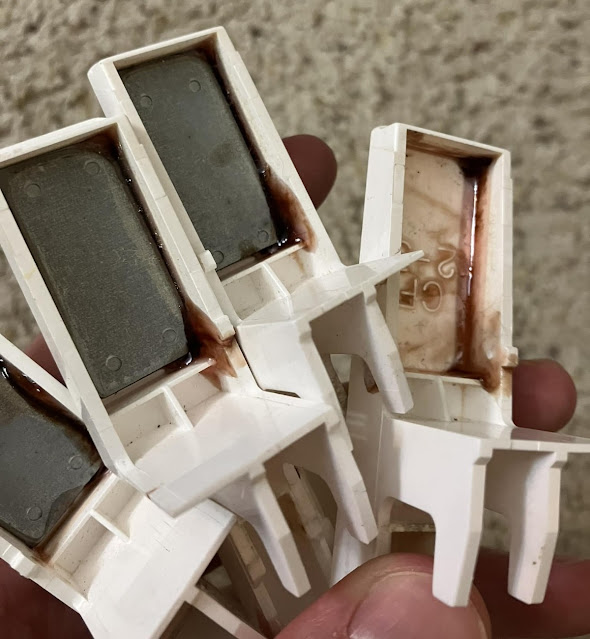It is really a nice white custom mod.
So, just see this:
.'.
This is a fan site for a great Synth! For the Roland JD-800 and of course, the JD-990 sound module. (coming back from Geocities)
 |
|
 |
 |
| Image from the DVD 'CLASSICAL WAKEMAN' Vol. 1- Live in Lugano |
 |
| Master Rick Wakeman is an English keyboard player, composer, and songwriter
best known as the keyboardist for progressive rock group Yes. Foto: StarCards |
This is a Mod to the JD-800 circuit. Do it at your own risk.
 |
| Photo: Gwydion Elderwyn |
A 270 kOhm resistor across R27 will make it possible to use full range of aftertouch without straining your fingers.
 |
| R27 position. Photo: Gwydion Elderwyn |
I poked around with a multimeter on the aftertouch circuit today. The pressure
ribbon starts out at 150 kOhm and by full pressure it is around 1 kOhm...
Shunting the ribbon will make it possible to move the threshold to make it start
earlier but will not make it more sensitive.
Preben
This is a modification you can do inside the JD if you are comfortable with a soldering iron that makes the aftertouch much more responsive.
This mod might require to unsolder a SMD resistor ... not something for people with ten thumbs.
For sure you can ask an electronics technician to perform this modification.
Removing all screws may do your internal components fall.
You must remove only the screws AROUND the bottom and two screws in the center line, they are at 1/4 from side, and may be you can see a few bigger hole where thy fit to.
Sometimes the bottom have some "dust" acting like glue to.
 |
| Photo: Gwydion Elderwyn |
 |
| How to remove the panel. JD-800 Manual. (click to enlarge) Source: Roland Co. |
 |
| Image by: Preben Friis |
What I'd like to do instead on this mod is replace the resistor by a lower value, cut the trace next to it and connect a 500Kohm trimmer pot with modding wire (26-28Awg) and have it adjustable.I imagine not every aftertouch ribbon has exactly the same value, so this would make it tweekable. Nice thing is if the value of the ribbon changes in time, all you have to do it open it up and adjust it a little. The fixed resistor is there as safeguard so the value doesnt go below a safe value and draws too much current.
Also, I would not connect a pot in parallel with the current value. The response of the pot would not be linear at all, and hard to adjust.
 |
| Foto: Yuri Alfons Peeters Charlotte |
 |
| Red glue. Photo by Alexander James Edwards |
Roland JD800 Environment
by virgo » Mon Mar 26, 2012 4:13 am
As promised in this thread (click to see post), here`s my little JD800 environment.
I will probably add the FX section sometime.
Original download link:
JD_800_Makro2.zip
JD800 Environment (590.51 KiB)
 |
| Not sure, at right top, appears to be the JD800 and a Nord. Foto: Music and You |
This was the next synth to follow the DX7 philosophy and the approach initiated by Japanese synths, which was going to financially sink all of the American makers. I included it in my list because it was one of the first polyphonic Japanese synths that managed to resemble an analogue synth, although what I hated about the DX7 was that it left you thinking that electronic music only aimed to imitate the sounds of acoustic instruments. With the JD-800, you could modify the sound, as you can on an ARP or a Moog, but with a Japanese sound quality, which in some respects, is more refined. I used this synth a lot on Chronology and Revolution. These are the albums which spoke to people the least, but which were important in my career as they marked a period of flux where I still had a foot in analogue and another in what would go on to become digital.
Jean-Michel Jarre
 |
| JD-VST Patch Editor |
At 4:40 this video shows a pad that you can create live using the JD-800's effects and sliders. I am using a Roland DP-2 footswitch to hold the chord down while I set the JD-800's phaser & delay. Then I change the cutoff and rez, and pitch with the "pitch coarse" knob. To get the "whoosing" effect you could set LFO1 on the filter. JD-800's resonance in full effect here but this is not using high settings. Other sounds in this video include crystal rhodes, strings, piano, PPG sounds, catherdral organ, of course basses and leads.

This is a fan-page.
JD-800 and JD-990 are @ copyright by Roland Corp.
I found all material (pictures, etc) at internet and sometimes I have not find the original sources to give credits.
If you own the copyrights of any material or information shown here and I miss your link OR you don´t agree with it´s use here, just send me a message and I will correct it.